What to Wear, Year Round
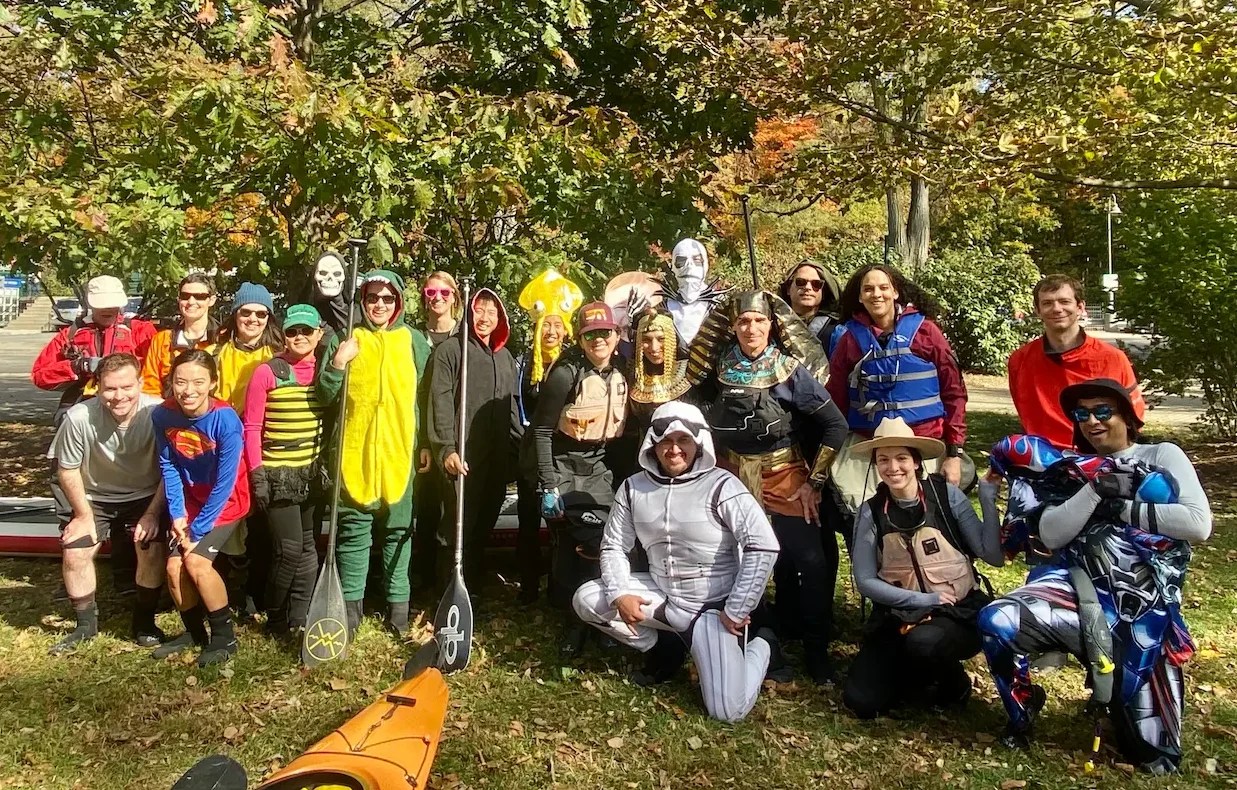
Stay fit and enjoy fresh air and sunshine year-round when you’re dressed right. The warm-water season (May 1–Oct 31) is when we run all beginner classes, trips, and rentals. Once you’ve finished our Basics series (or passed our screening) you’re considered intermediate and can keep paddling with us from November through April. Many paddlers discover our calmer, less crowded, beautiful waters after summer.
Life Jackets: A Constant
We provide Coast Guard-approved foam life jackets for every paddler and all seasons. The thick foam adds a layer of warmth on cooler days. Just show up and we’ll fit you with the right one.
Early Fall Season · Oct 1–Oct 31 · Beginner Friendly
Water temps above 60°F. It’s safe to paddle, even for first-timers. Most beginners splash themselves without realizing it though. Expect to get wet and bring extra clothes.
- Quick Drying Clothes: Wear a long-sleeve shirt and pants meant for athletics like hiking or running; most are polyester, which is best. Avoid cotton! It clings when wet and stays soaked. Most hoodies and jeans are cotton.
- Snug Hat: Wear a brimmed hat with a chin strap or a beanie. Wind blows away loose hats.
- Sturdy Soles: Wear sandals like Teva, Keen, Crocs, water shoes or old sneakers. No bare feet or flip flops now. If you need, borrow our neoprene booties to keep your feet warm, but keep your own socks on for hygiene
- Splash Jacket & Wetsuit (on cold days only): We provide these to you on windy or rainy days. Wear your shirt and undies underneath for hygiene.
Wetsuit Season · Nov 1–Dec 20 · Cozy & Intermediate+
Water temps 50–60°F. In cool water, we outfit you with a wetsuit, splash jacket, and neoprene booties. For hygiene, wear your own underlayers: non-cotton undies/briefs, a rashguard, and socks. A beanie is a smart extra. If you bring your own wetsuit, know that thick sleeves restrict shoulder movement…that’s why we prefer sleeveless wetsuits for cool water and switch to drysuits once the water is cold.
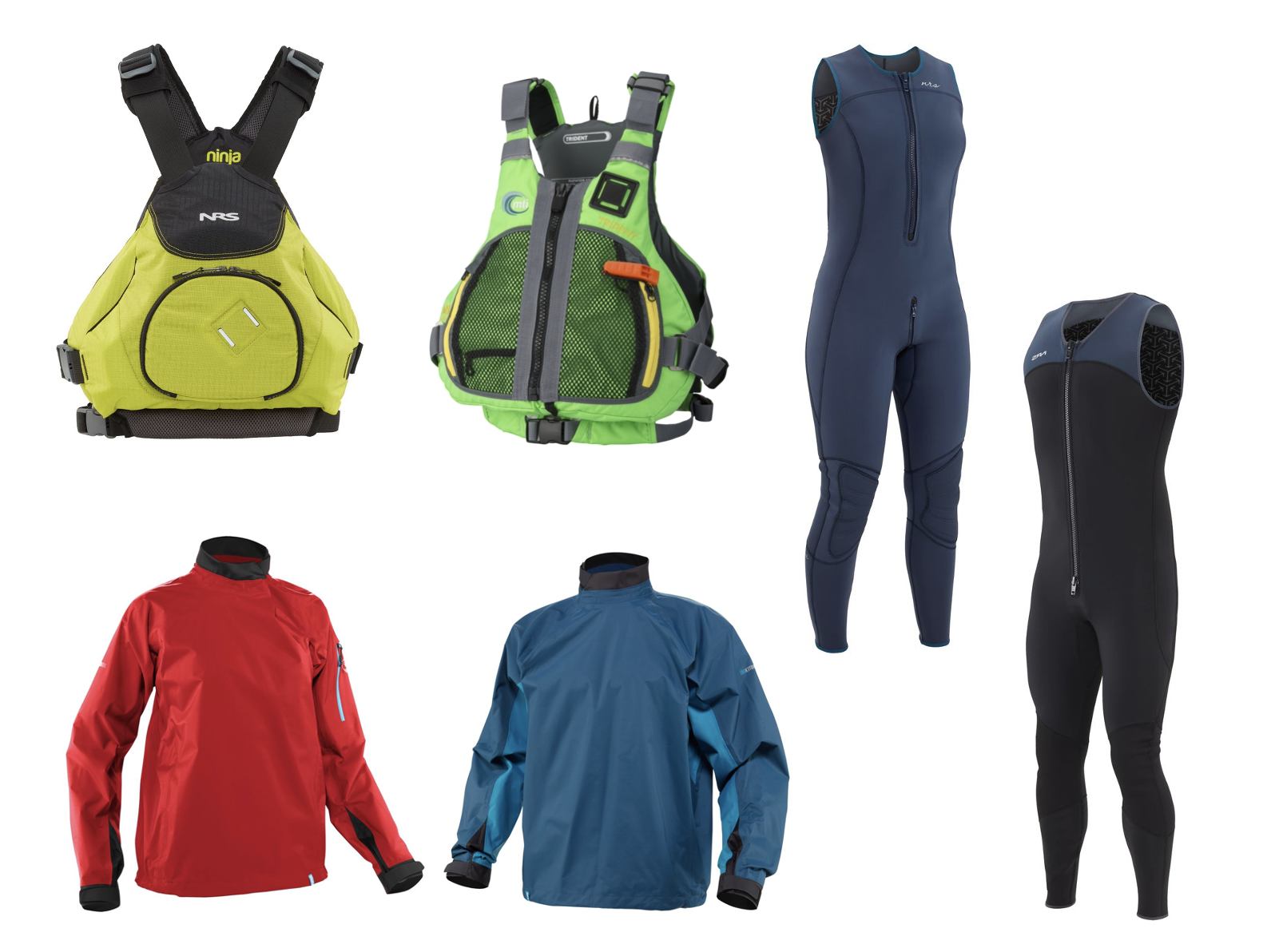
Clockwise from top left: NRS Ninja PFD; MTI Trident PFD; NRS Jane & John 3.0 Ultra wetsuits; NRS Endurance splash jackets.
Drysuit Season · Dec 21–Apr 30 · Serene & Special
Water temps under 50°F. Intermediate+ only…no beginners. Our winter regulars love these drysuits. They keep you dry using gaskets at the neck, wrists and ankles. Most paddlers bring their own. Members can borrow from our small pool of donated ones. The most affordable, eco-friendly option is eBay, but check sizing. Drysuits last for decades, but gaskets tear. Contact River Connection for repairs.
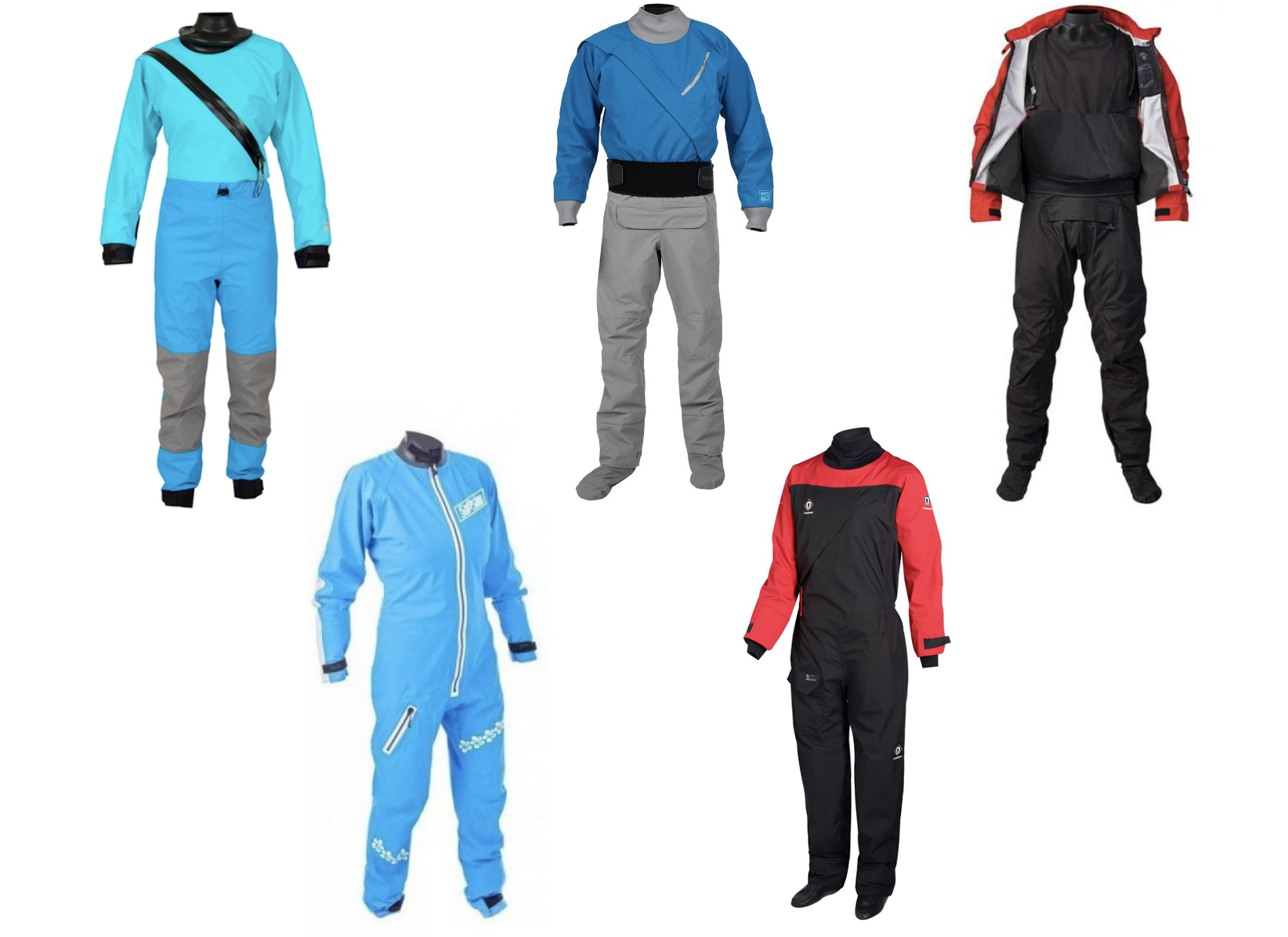
Clockwise from top left: Kokatat Hydrus drysuit; Kokatat Meridian drysuit; Stohlquist Shift drysuit; Crewsaver Atacama drysuit; SUPskin Dynamic drysuit.
Drysuit Underlayers: Finding Balance
Drysuits don’t insulate, so warmth depends on your tops and bottoms underneath. A heavier, airtight suit (like Kokatat) needs only a light base layer, while a thinner suit (like SUPSkin) calls for thick underlayers. Once you find your balance, you’ll be cozy all day. Wool and polyester are best.
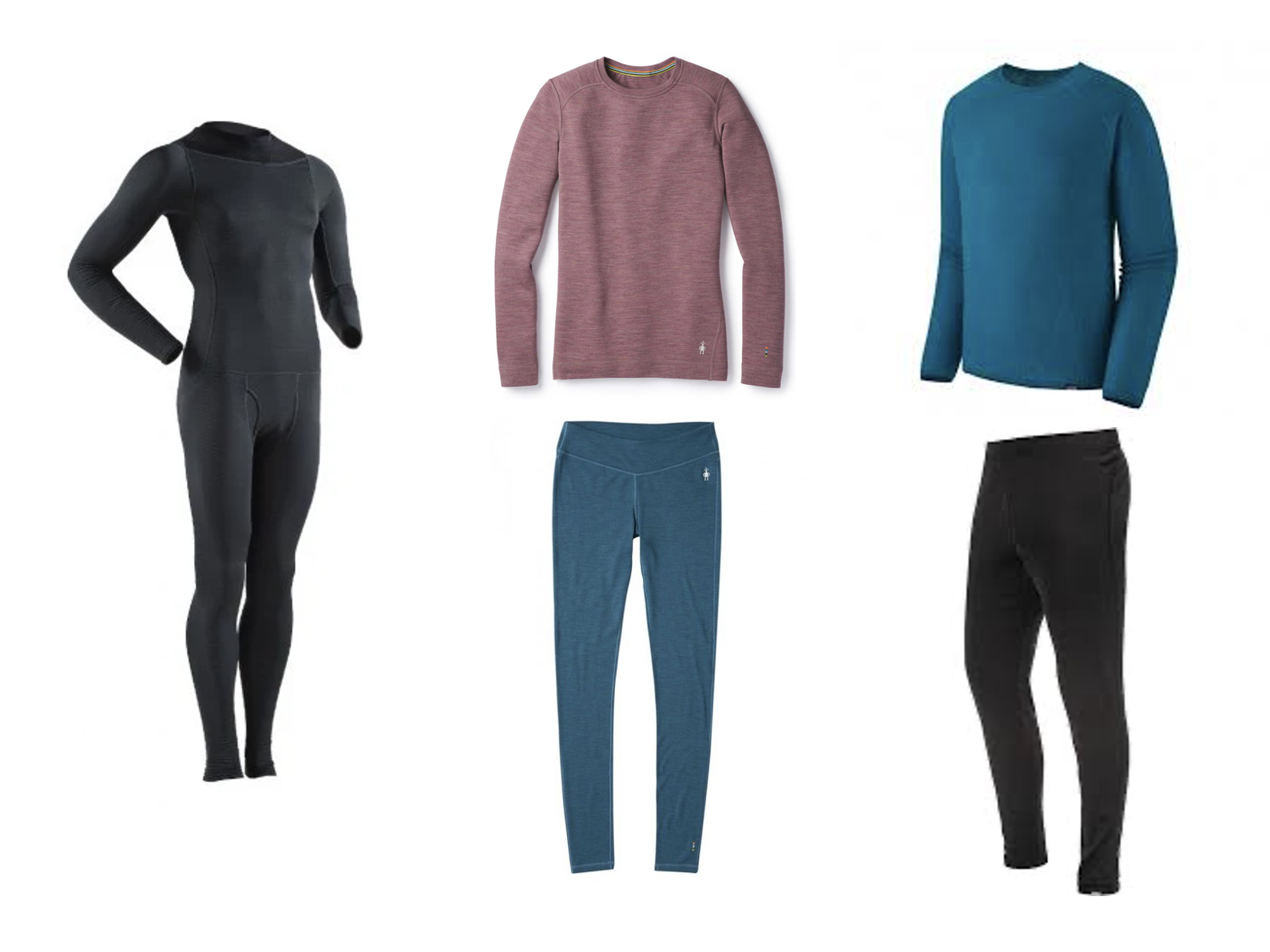
Clockwise from top left: Immersion Research Thick Skin; Smartwool 250 shirt; Patagonia Capilene shirt; Decathlon Simplewarm bottoms; Smartwool 250 bottoms.
Gear for Cool & Cold Water (November through April)
Handwear: Keep Fingers Warm
Gloves are important for cold days. For kayakers, pogies are best because they create a warm shell around your hands. They velcro around the paddle shaft and stay attached even if you let go. If you run cold, wear thin neoprene gloves under pogies. Paddleboarders rely on 1.5 mm curved gloves or 3 mm mitts. If gloves are thicker, they need pre-curved fingers like this to avoid hand fatigue.
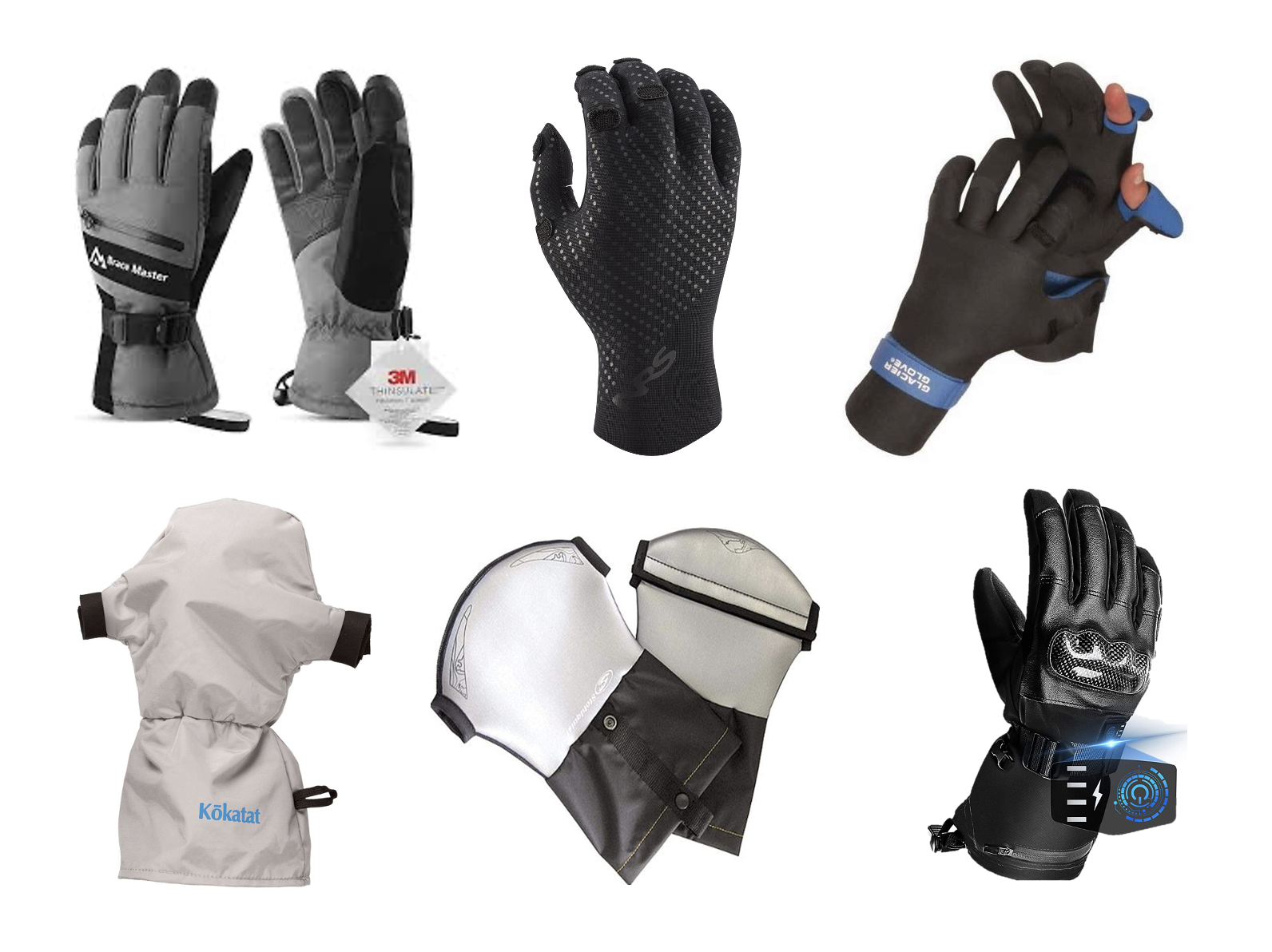
Clockwise from top left: Brace Master ski gloves; NRS HydroSkin 2mm gloves; Glacier Gloves; Shaalek heated gloves; Stohlquist Toaster pogies; Kokatat kayak mitt
Footwear: Neoprene & Wool
Wool socks inside neoprene boots (we have lots to borrow) = warm, happy feet, even when wet. 3-5 mm is for cool water, 7 mm is for cold water. If you get your own, look for a side zip so they’re easy to get off. Rinse and air-dry after use. Socks are essential yet bulky, so size up the booties.

Clockwise from top left: Smartwool socks; Kokatat dry socks; NeoSport 5 mm boots; Henderson Aqua Lock boots; Neosport 7 mm boots; NRS Remix shoes.
Headwear: Hold Heat
Your head loses heat quickly, so bring a hat even if the day’s warm. A fleece headband or a hat with ear flaps works well, and bright colors help you stay visible on the water.
Simple Extras: Small Comforts
Cool weather doesn’t require much more than summer. A 10–20 liter dry bag holds spare layers or hat. Pack snacks for energy and warmth. An insulated bottle filled with a hot drink can makes the day feel blissful. Our late kayaker Doron packed his big thermos of Turkish-style coffee with cups to share during wintertime breaks. 🥰

Clockwise from upper left: Thermos 24oz Stainless bottle; Clif Blok chews; Sea Dog 4-3/4” carabiner; AquaVault phone case; Rheos floating sunglasses; Sea to Summit 13L dry bag.
Plan Ahead
When you get new gear, test it on a calm, short outing first. That way, if it doesn’t work, you can adjust easily. Off-season paddlers who keep going while others pause leapfrog ahead in strength, skills, and friendships. With calmer rivers, fewer boats, and familiar faces, it’s the best time to build your foundation.

Photo: @161st_and_river
